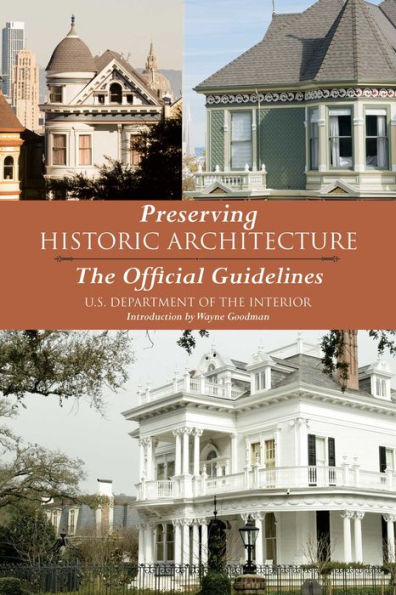Preserving Historic Architecture: The Official Guidelines
The National Park Service, a branch of the Department of the Interior, knows preservation. In its hundred-year existence, the service has dealt with just about every problem an old structure can have. Whether it is removing graffiti in Manhattan or rebuilding a barn in Oregon, the National Park Service knows what to do. Here are the official U.S. guidelines, a lively and instructive collection of tried and tested knowledge and reliable techniques, written by the top experts in the field.
Over forty fully illustrated chapters addressing topics such as:
— cleaning and waterproof coating of historic masonry
— roofing for historic buildings
— the preservation of historic glazed architectural terra-cotta
— exterior paint problems on historic woodwork — the preservation of historic barns
— heating, ventilating, and cooling historic buildings
— historic signs
— applied decoration for historic interiors
— using substitute materials on historic building exteriors
— understanding old buildings
— understanding architectural cast iron
Every chapter is written with the utmost detail and clarity so that any reader can perform the safest and most historically accurate repairs. The book also offers invaluable advice on what not to do that can save a homeowner thousands of dollars, hours, and perhaps a priceless piece of architecture. For the hobbyist or the professional restorer, The Preservation of Historic Architecture is the definitive government text on restoring, repairing, and preserving old buildings.
1111980494
Over forty fully illustrated chapters addressing topics such as:
— cleaning and waterproof coating of historic masonry
— roofing for historic buildings
— the preservation of historic glazed architectural terra-cotta
— exterior paint problems on historic woodwork — the preservation of historic barns
— heating, ventilating, and cooling historic buildings
— historic signs
— applied decoration for historic interiors
— using substitute materials on historic building exteriors
— understanding old buildings
— understanding architectural cast iron
Every chapter is written with the utmost detail and clarity so that any reader can perform the safest and most historically accurate repairs. The book also offers invaluable advice on what not to do that can save a homeowner thousands of dollars, hours, and perhaps a priceless piece of architecture. For the hobbyist or the professional restorer, The Preservation of Historic Architecture is the definitive government text on restoring, repairing, and preserving old buildings.
Preserving Historic Architecture: The Official Guidelines
The National Park Service, a branch of the Department of the Interior, knows preservation. In its hundred-year existence, the service has dealt with just about every problem an old structure can have. Whether it is removing graffiti in Manhattan or rebuilding a barn in Oregon, the National Park Service knows what to do. Here are the official U.S. guidelines, a lively and instructive collection of tried and tested knowledge and reliable techniques, written by the top experts in the field.
Over forty fully illustrated chapters addressing topics such as:
— cleaning and waterproof coating of historic masonry
— roofing for historic buildings
— the preservation of historic glazed architectural terra-cotta
— exterior paint problems on historic woodwork — the preservation of historic barns
— heating, ventilating, and cooling historic buildings
— historic signs
— applied decoration for historic interiors
— using substitute materials on historic building exteriors
— understanding old buildings
— understanding architectural cast iron
Every chapter is written with the utmost detail and clarity so that any reader can perform the safest and most historically accurate repairs. The book also offers invaluable advice on what not to do that can save a homeowner thousands of dollars, hours, and perhaps a priceless piece of architecture. For the hobbyist or the professional restorer, The Preservation of Historic Architecture is the definitive government text on restoring, repairing, and preserving old buildings.
Over forty fully illustrated chapters addressing topics such as:
— cleaning and waterproof coating of historic masonry
— roofing for historic buildings
— the preservation of historic glazed architectural terra-cotta
— exterior paint problems on historic woodwork — the preservation of historic barns
— heating, ventilating, and cooling historic buildings
— historic signs
— applied decoration for historic interiors
— using substitute materials on historic building exteriors
— understanding old buildings
— understanding architectural cast iron
Every chapter is written with the utmost detail and clarity so that any reader can perform the safest and most historically accurate repairs. The book also offers invaluable advice on what not to do that can save a homeowner thousands of dollars, hours, and perhaps a priceless piece of architecture. For the hobbyist or the professional restorer, The Preservation of Historic Architecture is the definitive government text on restoring, repairing, and preserving old buildings.
17.99
In Stock
5
1

Preserving Historic Architecture: The Official Guidelines
640
Preserving Historic Architecture: The Official Guidelines
640
17.99
In Stock

From the B&N Reads Blog
